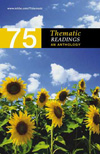
Maya Angelou |  |
Maya AngelouMaya Angelou, "Graduation" Maya Angelou (1928- ) was born in St. Louis, and attended public schools
in Stamps, Arkansas and San Francisco. She writes poetry, nonfiction,
children's books, plays and screenplays, and music. Her books include
the memoir I Know Why the Caged Bird Sings (1970), the book of
poetry Life Doesn't Frighten Me (1993), and the book of essays
Even the Stars Look Lonesome (1997). Angelou is also a frequent
contributor to film, as a writer, performer, and director. Her work in
this area includes acting in the film How to Make an American Quilt
(1995), directing Down in the Delta (1998), and appearing as a
guest star on such shows as Moesha and Touched by an Angel.
She frequently contributes stories and poems to periodicals such
as Black Scholar, Redbook magazine, and Essence.
Angelou holds numerous honorary degrees, has won a Grammy award, and wrote
her poem "On the Pulse of the Morning" at Bill Clinton's request
so she could recite it at his first inauguration. "Graduation"
is an excerpt from I Know Why the Caged Bird Sings. | QUESTIONS FOR DISCUSSION | CONTENT - How did Angelou's high school differ from Lafayette County Training
School, the white school?
- What does the author mean by the phrase "glorious release"
in the first paragraph?
- Describe what the author's mother does to her graduation dress.
- What gift does Bailey give his sister? What does Momma give her?
- Who takes the principal's seat during the ceremony? How does the
minister react?
- How does the author feel about the class valedictorian Henry Reed?
What do you make of her description of him?
- What dividing line between white and black students does Edward
Donleavy draw in his speech? How does the audience react? What further
line does the author point out?
STRATEGY AND STYLE - In what way is the capitalization of the word store unusual
in paragraph six? How does this reflect the author's relationship
with it?
- "Graduation" is a narration about a part of one specific
woman's life, but it has widespread significance. What are some of
the ways Angelou makes this more than just the story of a single individual?
Where in the essay did you go to support your answer?
- In paragraph twenty-five, you'll find this sentence: "We all
laughed, nicely." What is the effect of the word nicely?
What would the sentence lose without it? How can you relate this usage
to the moment being described?
- Discuss the image of the "pyramid of flesh." Why do you
think the author uses a pyramid and not some other shape?
- Examine the description in paragraph nine. Are the changes that
the author describes really more in her, or more in her surroundings?
Could it be a combination of the two? Use specific evidence from that
paragraph to support your answer.
| ENGAGING THE TEXT | - Recall a time when someone pigeonholed you due to your physical appearance.
How did it make you feel? What did you do about it? How can you relate
your feelings to this piece?
-
Describe either your grade school or high school graduation. Compare
and contrast your recollection with your experience of reading this
piece.
| SUGGESTIONS FOR SUSTAINED WRITING | - Write an essay tracing the arc of the moods the graduates felt on
and around their special day.
- Write a five-paragraph biography of one of the five historical figures
named in paragraph forty-six. How did the things you learned about your
subject enhance your understanding of "Graduation"?
| FOR FURTHER RESEARCH | Find the complete song "Lift Ev'ry Voice and Sing" by James
Weldon Johnson. Do some research about the circumstances surrounding its
composition, and to learn about the song's history and the life of Johnson.
Construct an argument about Angelou's use of the song. Why did she use
the parts she did? Why did she omit the parts she did? | WEB CONNECTION | If you'd like to put Angelou's work into historical context, you will
want to know something about the Civil Rights Movement in the U.S. To
get you started, here's a good general introduction
to segregation and Jim Crow from The Columbia Encyclopedia,
as well as related links. | LINKS | Biographical Are you unsure of where to start your online research? You'll find
a biography, a photo, two bibliographies, and some links at Angelou's
page
at the Voices From the Gaps site. An interesting way to see the scope of Angelou's work is to browse
through the list of her citations at the Library
of Congress. What did you find there that you didn't know before
your visit? If you're interested in the personal touch, you can click here
to see what Angelou's signature looks like in a first edition of All
God's Children Need Traveling Shoes.
Bibliographical Here is Angelou's etext "On
the Pulse of Morning," a poem she read at Bill Clinton's first
inauguration. She was the second poet to be so honored by a President
of the United States. (The first pairing was Robert Frost and John F.
Kennedy.) Here's a speech
she gave at Weber State University. It's the Distinguished Annie Clark
Tanner Lecture at the 16th-annual Families Alive Conference, 1997. This is an interview
from Mother Jones magazine in which Angelou participates in a
lively discussion about art and politics in the U.S.
Cultural Here is information
about a film that Angelou directed in 1998 called Down in the Delta.
How might you make use of this information if you were to write about
Angelou's life and work? Would you like to expand your knowledge about this author's personal
history? This is a chronology of recent
events in her life from her official website. How has Angelou interacted with other artists? Start your quest to
find out with some information
about her collaboration with the painter Jean-Paul Basquiat.
|
|
|
|